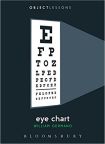Eye Chart (Object Lessons) by William Germano
| Eye Chart (Object Lessons) by William Germano | |
|
| |
| Category: Popular Science | |
| Reviewer: John Lloyd | |
| Summary: Get an eyeful of this – it's a great little read about something you wouldn't expect to find fun in the exploration of. | |
| Buy? Yes | Borrow? Yes |
| Pages: 160 | Date: September 2017 |
| Publisher: Bloomsbury Academic | |
| ISBN: 9781501312342 | |
|
| |
It's happened to me, and like as not it has or will happen to you, too. I mean the receipt of certain little numerical results, with a positive or negative before them to prove the correction needed to my vision to make me see with the intended clarity and normality. I've had that gizmo that photos the back of my eye to check for diabetes and other problems, I've had different tests to check the pressure inside my eye, and I've come away with glasses I don't need to wear all the time, but certainly benefit from on holiday, or when watching TV or a cinema or theatre production. And above and beyond that I've stared at – and got wrong – the simple, seemingly ageless test, of various letters in various configurations that diminish in size, to prove to the relevant scientist at what stage things get blurry for me. Of course it's not ageless, but the scientific progress that led to it, the changes other people made to it, and the cultural impact it's had are all on these eye-opening small pages.
In starting this review from my point of view I'm deliberately suggesting the personal approach of this book, and indeed this whole series, as it can take that stance with anything it turns its hand to, and convey things in an academic but not strictly scientific process. This book is perhaps a lot more diligent than others, for it has a full narrative to go through and the author is so damned genned up on it he knows a lot that is of interest, however much you don't expect to find relevant to your usual reading taste. Here is the first artwork to feature a man wearing glasses, here is the test for telescopes in Italy that was more or less the first instance of using text to check visual clarity and improvement, and here is all the science behind those much misrepresented 20/20 figures (it's not the perfect score, more an expected achievement, and I used to surpass it with ease).
In looking at the wider picture, the book can also focus on the titular topic – that of the Snellen eye test. And you will probably be surprised at how engaging trivia about it can be. The initial font for it was a throwback to Egyptian colonialism. It used to be just the one layout all the time, and anyone with the erudition to remember it could cheat and recite it annually, for it used to be something to be seen once a year, which our author likens to an array of Christmas cards or Easter service schedule. But even now it can be adapted and altered for every optician visit and for each eye, even if it only ever uses nine different letters (so no, you will never see an H or R as they're not in the nine). Its first commercial success was when it was adopted by British forces to test recruits, until it was worked out a full 9% of them could not read to the extent of knowing one letter from another. All of this is wonderful, in my estimation.
There is also a lot I think I would have cut, though – perhaps the editor has someone working for them that is so colour-blind he failed the Ishihara test (and it is much more regularly men that do than women) and missed the red ink. The diversions can add to the irreverence of the book in pleasant ways at times, distracting ways at others. I didn't think the section regarding The Invisible Man (who of course would have failed a sight test, being completely blind), supersight and other ocular wonders added anything. Several times the historical reportage and academic consideration both stumbled over their own feet in a hurry to get everything down on the page.
But this is an academic book for the stereotypical man on the stereotypical bus. The series is intended to be that way – to bring something from the periphery of our vision into sharp focus for a couple of hours, so we have a fully different estimation of it afterwards. The fact a professor of literature can do that so eloquently and warmly about such a scientific and unexpected subject is really very impressive indeed. I can see people in the ocular industry finding much that's new on these pages, and as for the average reader, who like as not never thought to ever think about something so unusual – they have a veritable bijou box of delights.
I must thank the publishers for my review copy.
Our favourite in this series was Bookshelf (Object Lessons) by Lydia Pyne, but we're biased towards that sort of bookish thing.
Please share on: ![]() Facebook,
Facebook, ![]() Twitter and
Twitter and
![]() Instagram
Instagram
![]() You can read more book reviews or buy Eye Chart (Object Lessons) by William Germano at Amazon.co.uk Amazon currently charges £2.99 for standard delivery for orders under £20, over which delivery is free.
You can read more book reviews or buy Eye Chart (Object Lessons) by William Germano at Amazon.co.uk Amazon currently charges £2.99 for standard delivery for orders under £20, over which delivery is free.
![]() You can read more book reviews or buy Eye Chart (Object Lessons) by William Germano at Amazon.com.
You can read more book reviews or buy Eye Chart (Object Lessons) by William Germano at Amazon.com.
Comments
Like to comment on this review?
Just send us an email and we'll put the best up on the site.


